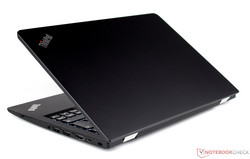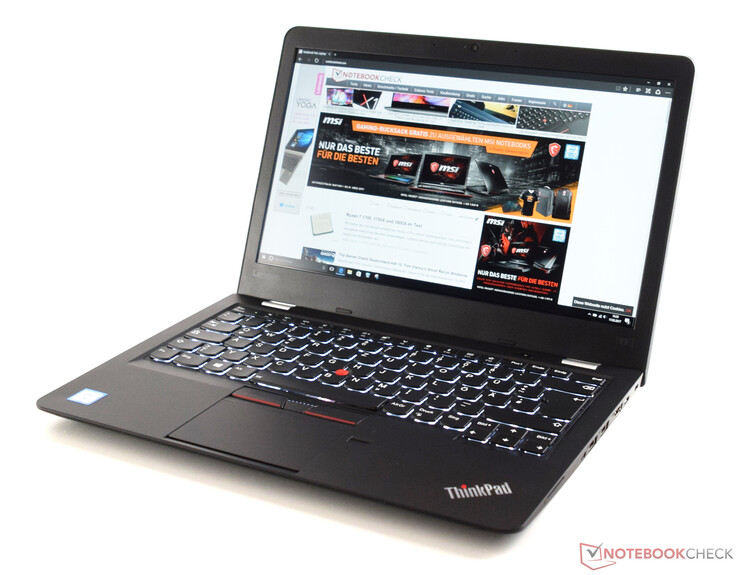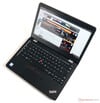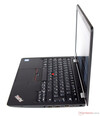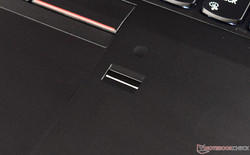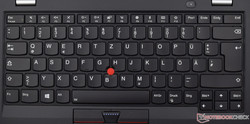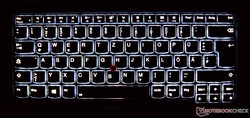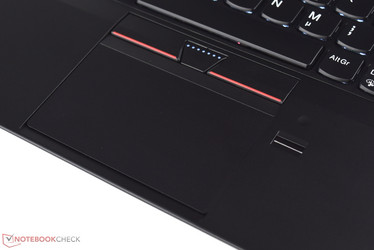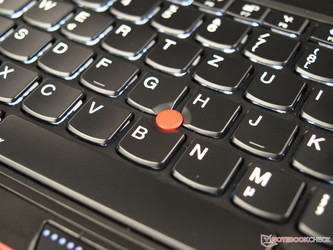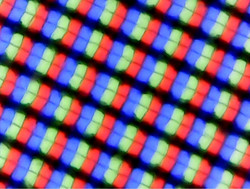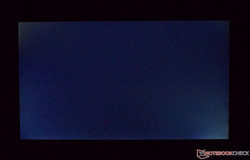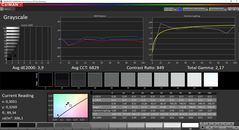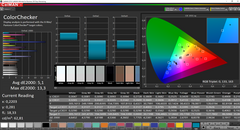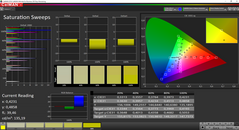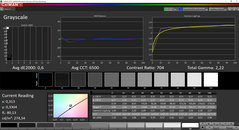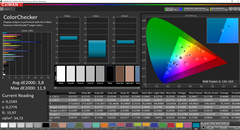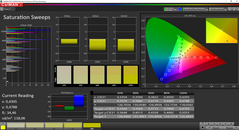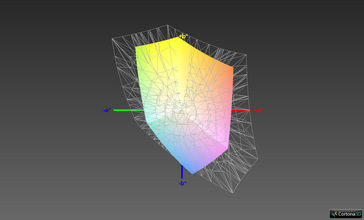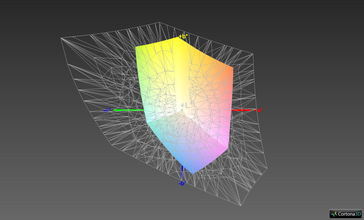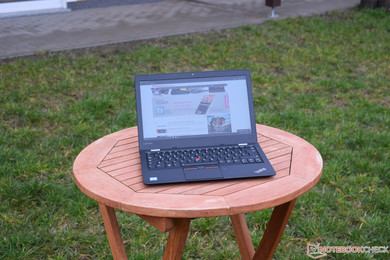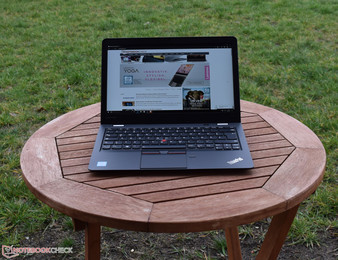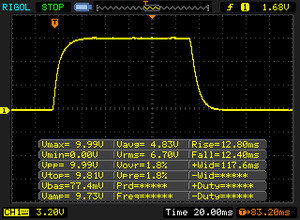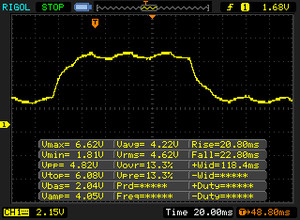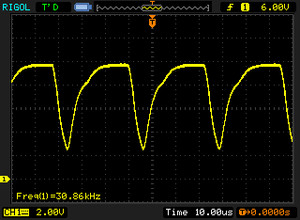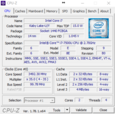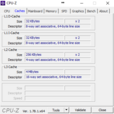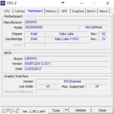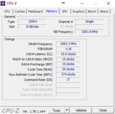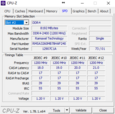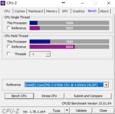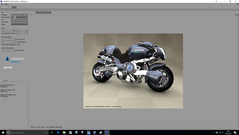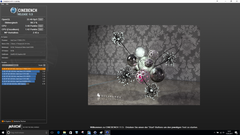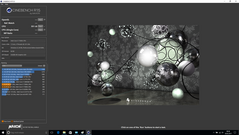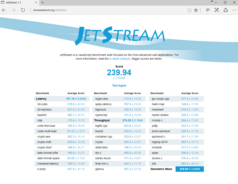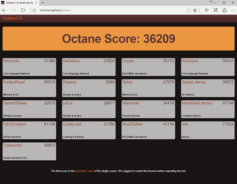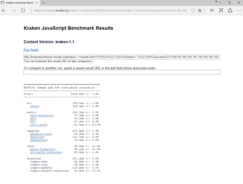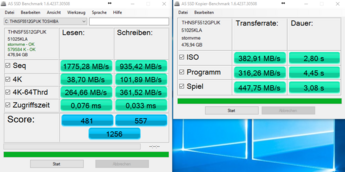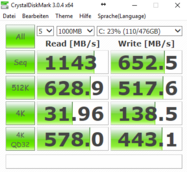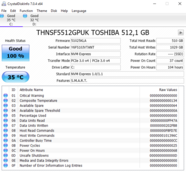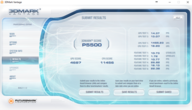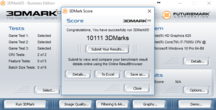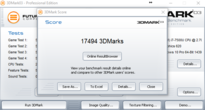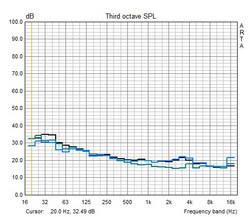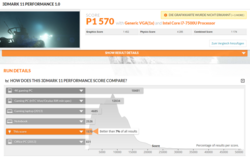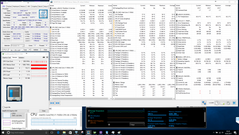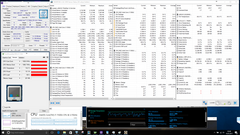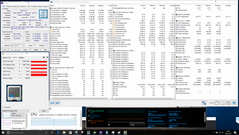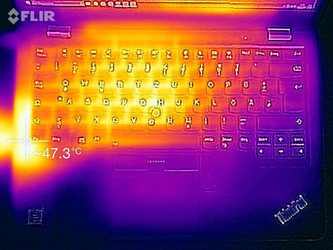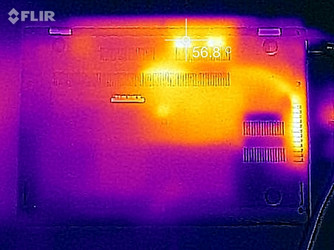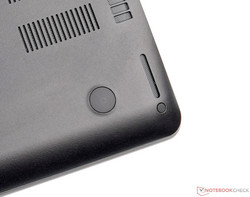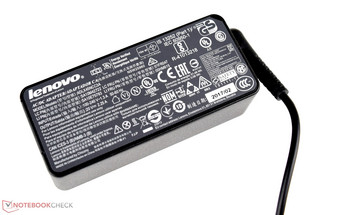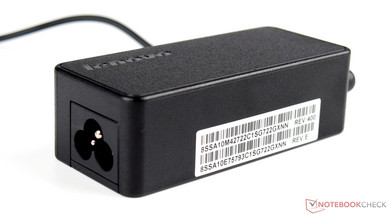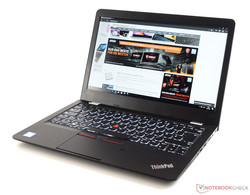Courte critique du Pc portable Lenovo ThinkPad 13 2017 (Core i7, Full-HD)

For the original German review, see here.
Compact devices are very popular in the business sector. The trend of the last few years is ongoing and compact devices are becoming increasingly more powerful. Lenovo's ThinkPad 13 lineup starts very conservatively at 759 Euros (~$820). For this price, the manufacturer has installed Intel's Core i3-7100U and 4 GB of DDR4 RAM. However, only an HD panel (TN) is offered here. The FHD (IPS) model is priced at 819 Euros (~$885). Lenovo is also offering Intel's Core i5-7200U and the premium Intel's Core i7-7500U as alternative processors. The latter is also in our review sample, together with16 GB of working memory and a 512 GB SSD that is connected via PCIe. Lenovo has installed the FHD panel here. The ThinkPad 13 is also available with a multi-touchscreen. Our review sample is a Campus Special Edition (without an operating system) for 999 Euros (~$1080). The corresponding configuration costs approximately 1230 Euros (~$1329) in Lenovo's online shop at the time of testing (including the operating system).
The installed CPU differentiates the three basic configurations. The device can be customized according to personal needs in the manufacturer's web shop.
We have selected devices from the same price category for this test. However, once more, the Skylake predecessor must also be included in the comparison. We have created a short list of the comparison devices’ most important specifications:
Top 10
» Le Top 10 des PC portables multimédia
» Le Top 10 des PC portables de jeu
» Le Top 10 des PC portables de jeu légers
» Le Top 10 des ordinateurs portables bureautiques
» Le Top 10 des PC portables bureautiques premium/professionnels
» Le Top 10 des Stations de travail mobiles
» Le Top 10 des Ultraportables
» Le Top 10 des Ultrabooks
» Le Top 10 des Convertibles
» Le Top 10 des Tablettes
» Le Top 10 des Tablettes Windows
» Le Top 10 des Smartphones
» Le Top 10 des PC Portables á moins de 300 euros
» Le Top 10 des PC Portables á moins de 500 euros
» Le Top 25 des meilleurs écrans d'ordinateurs
| Lenovo ThinkPad 13 | HP ProBook 430 G4 | Asus ZenBook UX310UA | Dell XPS 13 9360 | |
| CPU | Intel Core i5-6200U | Intel Core i7-7500U | Intel Core i7-7500U | Intel Core i5-7200U |
| GPU | Intel HD Graphics 520 | Intel HD Graphics 620 | Intel HD Graphics 620 | Intel HD Graphics 620 |
| Panel | 13.3-inch FHD | 13.3-inch FHD | 13.3-inch FHD | 13.3-inch FHD |
| RAM | 8 GB DDR4-2133 | 8 GB DDR4-2133 | 16 GB DDR4-2133 | 8 GB DDR3-1866 |
| Price | 850 Euros | 1050 Euros | 999 Euros | 1299 Euros |
Case
Lenovo's ThinkPad 13 second generation closely follows the looks of its direct predecessor. The eye-catching details immediately show that this device is a member of the ThinkPad family. Unlike the silver model that is made of aluminum. Lenovo's black ThinkPad 13 (2017) is made of PC/ABS plastic. A magnesium frame that gives more strength to the base has not been incorporated into our review sample. The compact laptop is solid but it can be dented visibly in the keyboard area. Warping without damaging the device is hardly possible. However, quiet cracking noises were audible when we tried to twist the laptop. According to the specification sheet, Lenovo's ThinkPad 13 (2017) has a MIL-STD-810G certificate. It should be noted that Lenovo does not specify what this means. Lenovo's homepage only speaks of 12 military tests.
At a first glance, the thick display lid gives the device a relatively rigid appearance. However, this is deceiving as the plastic lid is easy to twist. Furthermore, pressure from the back produces wave formation on the screen. Although the hinges keep the display in place, they cannot prevent it from rocking visibly. We would have expected better quality components here.
The silver ThinkPad 13 made of aluminum did a considerably better job than our review sample in terms of base and casing lid stability.
Size Comparison
In terms of space, Lenovo's ThinkPad 13 (2017) is midfield. Dell's XPS 13 9360 needs the least space on the desk. However, we would not call the review sample bulky or too big. Its dimensions are acceptable for a device from the 13-inch category. With a weight of approximately 1.4 kg (~3.1 lb), Lenovo's ThinkPad 13 (2017) is on par with its predecessor and Asus' ZenBook UX310UA. The power supply adds 300 grams (~10.6 oz), which equates to a weight of 1.7 kg (~3.7 lb). This is a pleasant weight, considering that Lenovo's ThinkPad 13 (2017) is designed for mobile use.
Connectivity
In terms of interfaces, there are no changes between Lenovo's second generation ThinkPad 13 and its predecessor. All major interfaces and one USB 3.0 Type-C are present. However, the latter is only a gen.1 port that supports video output via DisplayPort (max. 3840x2160 pixels, 60Hz). All interfaces are located in the rear on the sides. We deem this distribution as ideal. The ports' spacing is sufficient and will not obstruct each other. Lenovo's ThinkPad 13 (2017) has a OneLink+ docking port on its left. The manufacturer's proprietary docking solutions can be connected here.
SD Card Reader
The performance of the memory card reader in the predecessor was not convincing. Once again, we have to criticize this in the new model. Lenovo's ThinkPad 13 (2017) achieved only 22.8 MB/s in copying JPG files. According to AS SSD, the sequential read rate was just 27 MB/s. We used the Toshiba Exceria Pro SDXC 64 GB UHS-II memory card. Dell's XPS 9360 clearly exhibited its potential. Thus, we recommend using an external solution via the USB port to users who depend on this interface.
| SD Card Reader | |
| average JPG Copy Test (av. of 3 runs) | |
| Dell XPS 13 9360 FHD i5 | |
| HP ProBook 430 G4-Y8B47EA | |
| Asus Zenbook UX310UA-FC347T iGP | |
| Lenovo ThinkPad 13-20GKS01100 | |
| Lenovo ThinkPad 13-20J2S00G00 | |
| maximum AS SSD Seq Read Test (1GB) | |
| Dell XPS 13 9360 FHD i5 | |
| HP ProBook 430 G4-Y8B47EA | |
| Asus Zenbook UX310UA-FC347T iGP | |
| Lenovo ThinkPad 13-20GKS01100 | |
| Lenovo ThinkPad 13-20J2S00G00 | |
Communication
Lenovo's ThinkPad 13 does not have an Ethernet port. Thus, only wireless Internet access is possible. The manufacturer has installed an Intel Dual Band Wireless-AC 8265-Modul in our review sample. The Wi-Fi module supports all common standards including the fast 802.11ac in both the 2.4 and 5 GHz networks. Although technically the Bluetooth 4.2 standard is supported, the Windows operating system limits it and only Bluetooth 4.1 can be used. Lenovo's ThinkPad 13 (2017) receives data at a very good 645 Mbit/s. On the other hand; our review sample falls behind a bit with 297 Mbit/s in transmitting data. We used the Linksys EA8500 router for testing. There were no problems with the connection quality.
Users who prefer cabled network connections will have to purchase a corresponding docking station (OneLink+) or a suitable USB adapter.
| Networking | |
| iperf3 transmit AX12 | |
| Asus Zenbook UX310UA-FC347T iGP (jseb) | |
| Dell XPS 13 9360 FHD i5 | |
| Lenovo ThinkPad 13-20J2S00G00 | |
| iperf3 receive AX12 | |
| Lenovo ThinkPad 13-20J2S00G00 | |
| Dell XPS 13 9360 FHD i5 | |
| Asus Zenbook UX310UA-FC347T iGP (jseb) | |
Security
Security features are highly valued, particularly in business devices. Although Lenovo has implemented a few of these, some competitors offer better optional comprehensive solutions. Be that as it may, Lenovo's ThinkPad 13 (2017) offers a fingerprint scanner and TPM 2.0. The 512-GB SSD supports auto-encryption in the OPAL 2.0 standard. The fingerprint scanner is only a model where the finger has to be swiped across it. Higher-quality business laptops often have a faster and more reliable touch sensor. The device can also be secured via a Kensington Lock. However, a SmartCard reader is not present.
All new Lenovo ThinkPad models come with a 30-day subscription for Norton's Internet Security. Further security software can be purchased optionally. However, this only applies to devices that are delivered with an operating system.
Accessories
We find only the compact 45-watt power supply and the usual service leaflets concerning service and warranty conditions in the box. Lenovo offers many optional accessories for its ThinkPad 13 (2017). The docking stations that are connected to the laptop via the proprietary OneLink+ or USB are particularly interesting. The corresponding docking stations cost between 200 and 250 Euros (~$216 to ~$270). An overview of the technical specifications can be found here.
Maintenance
As with the predecessor, maintenance is difficult. This was to be anticipated since both devices use the same casing. The base still sits extremely tight after releasing the screws and a multitude of additional plastic clasps that secure it. Once again, we aborted the attempt of disassembling the device in order to prevent damage. We would greatly appreciate it if Lenovo would at least integrated a maintenance hatch for accessing the SSD or RAM in future devices.
Warranty
Lenovo's ThinkPad 13 (2017) is sold with a 12-month base warranty. It can be extended to 48 months for a one-time payment of 212 Euros (~$229). A 36-month upgrade costs 118 Euros (~$127).
Input Devices
A well-built chiclet keyboard is installed into our review sample. The individual keys have a good size of 17 x 17 millimeters (~0.7 x 0.7 in) and a pleasant drop. They round off the package with a decent stroke. It is not too spongy, making fast typing possible. It is quite obvious that this is currently one of the best input devices on the market as its typing noise is also kept within agreeable limits.
The keys' surfaces are sleek but they still have enough grip. The white lettering is well-legible on each key. The new ThinkPad 13 now offers an optional keyboard backlight that can be set in two brightness levels. Our review sample features this backlight that can be added to the order in the manufacturer's web shop. It costs an extra 24 Euros (~$26), in our opinion, definitely a useful investment.
Touchpad / TrackPoint
The mouse cursor can be moved over the screen with either the TrackPoint or the ClickPad. Both input options function impeccably. The three dedicated buttons that are situated above the 9 x 5.5 centimeter (~3.5 x 2.2 in) ClickPad are pleasingly quiet when used. On the other hand, inputs via the ClickPad produce a relatively loud click noise. The input devices do not involve any restrictions, and thus Lenovo makes the high-quality impression as with the keyboard.
Display
Buyers can choose from three different screens. First, a Full HD panel like the one in our review sample, then a Full HD IPS screen with multi-touch support, and the manufacturer uses a TN panel with HD resolution in the cheapest model. The 60 Euros (~$65) extra for the FHD screen in our review sample are a worthwhile investment. All three are advertised with 250 cd/m².
The measurements of our device are slightly higher than the specifications. With an average brightness of 307 cd/m², Lenovo's ThinkPad 13 (2017) takes the third place. The screens in Asus' ZenBook UX310UA (347 cd/m²) and Dell's XPS 13 9360 (325 cd/m²) have a slightly higher brightness. Nevertheless, the brightness is good and the illumination of 89% is decent. Unfortunately, the screen in our review sample has some problems with backlight bleeding. This is particularly visible in the upper left and lower right corners on a completely black screen. However, this did not lead to any major restrictions during everyday use.
| |||||||||||||||||||||||||
Homogénéité de la luminosité: 89 %
Valeur mesurée au centre, sur batterie: 306 cd/m²
Contraste: 850:1 (Valeurs des noirs: 0.36 cd/m²)
ΔE ColorChecker Calman: 5.1 | ∀{0.5-29.43 Ø4.78}
ΔE Greyscale Calman: 3.9 | ∀{0.09-98 Ø5}
59.75% sRGB (Argyll 1.6.3 3D)
38.24% AdobeRGB 1998 (Argyll 1.6.3 3D)
41.54% AdobeRGB 1998 (Argyll 3D)
60% sRGB (Argyll 3D)
40.16% Display P3 (Argyll 3D)
Gamma: 2.17
CCT: 6829 K
| Lenovo ThinkPad 13-20J2S00G00 LP133WF2-SPL78, , 1920x1080, 13.3" | Lenovo ThinkPad 13-20GKS01100 LP133WF2-SPL1, , 1920x1080, 13.3" | HP ProBook 430 G4-Y8B47EA LGD052D, , 1920x1080, 13.3" | Asus Zenbook UX310UA-FC347T iGP AU Optronics AUO272D, , 1920x1080, 13.3" | Dell XPS 13 9360 FHD i5 Sharp SHP1449 LQ133M1, , 1920x1080, 13.3" | |
|---|---|---|---|---|---|
| Display | -5% | -4% | 42% | 22% | |
| Display P3 Coverage (%) | 40.16 | 38.35 -5% | 38.55 -4% | 64.2 60% | 48.94 22% |
| sRGB Coverage (%) | 60 | 57.4 -4% | 57.8 -4% | 65.3 9% | 73.3 22% |
| AdobeRGB 1998 Coverage (%) | 41.54 | 39.66 -5% | 39.85 -4% | 65.3 57% | 50.5 22% |
| Response Times | -3% | -1% | 11% | -4% | |
| Response Time Grey 50% / Grey 80% * (ms) | 43.6 ? | 43.2 ? 1% | 42.4 ? 3% | 40 ? 8% | 32.8 ? 25% |
| Response Time Black / White * (ms) | 25.2 ? | 26.8 ? -6% | 26.4 ? -5% | 22 ? 13% | 33.2 ? -32% |
| PWM Frequency (Hz) | 30860 ? | 200 ? | |||
| Screen | -1% | -4% | 18% | 15% | |
| Brightness middle (cd/m²) | 306 | 233 -24% | 253 -17% | 358 17% | 351.2 15% |
| Brightness (cd/m²) | 307 | 227 -26% | 249 -19% | 347 13% | 325 6% |
| Brightness Distribution (%) | 89 | 86 -3% | 92 3% | 87 -2% | 89 0% |
| Black Level * (cd/m²) | 0.36 | 0.22 39% | 0.32 11% | 0.26 28% | 0.195 46% |
| Contrast (:1) | 850 | 1059 25% | 791 -7% | 1377 62% | 1801 112% |
| Colorchecker dE 2000 * | 5.1 | 5.41 -6% | 5.28 -4% | 5.22 -2% | 7.4 -45% |
| Colorchecker dE 2000 max. * | 13.3 | 13.61 -2% | 13.66 -3% | 9.19 31% | 9.08 32% |
| Greyscale dE 2000 * | 3.9 | 4.15 -6% | 3.8 3% | 6.69 -72% | 6.71 -72% |
| Gamma | 2.17 101% | 2.45 90% | 2.3 96% | 2.35 94% | 2.74 80% |
| CCT | 6829 95% | 6773 96% | 6646 98% | 6745 96% | 7222 90% |
| Color Space (Percent of AdobeRGB 1998) (%) | 38.24 | 36.52 -4% | 36.7 -4% | 59 54% | 50.48 32% |
| Color Space (Percent of sRGB) (%) | 59.75 | 57.16 -4% | 57.6 -4% | 91 52% | 73.31 23% |
| Moyenne finale (programmes/paramètres) | -3% /
-2% | -3% /
-4% | 24% /
22% | 11% /
14% |
* ... Moindre est la valeur, meilleures sont les performances
The average DeltaE 2000 deviations in grayscale and colors compared with the sRGB color space were already 3.9 and 5.1 ex-factory. This is quite good without calibrating, although some peaks can be seen in the blue tones (>13). The grayscale levels in particular benefit from calibration as their DeltaE 2000 deviation then drops to a very good 0.6. The DeltaE 2000 deviation of the colors is then just 3.1 after calibration.
Although the color space coverage has improved slightly compared with the predecessor, the 60% sRGB and 38% AdobeRGB are far from sufficient for (semi) professional photo editing.
The screen has an average brightness of 306 cd/m² in battery mode, which means that it is not dimmed. This, in conjunction with the screen's matte surface, makes Lenovo's ThinkPad 13 (2017) suitable for outdoor use. However, for comfortable working, we recommend using it in the shade where possible.
Temps de réponse de l'écran
| ↔ Temps de réponse noir à blanc | ||
|---|---|---|
| 25.2 ms ... hausse ↗ et chute ↘ combinées | ↗ 12.8 ms hausse | |
| ↘ 12.4 ms chute | ||
| L'écran souffre de latences relativement élevées, insuffisant pour le jeu. En comparaison, tous les appareils testés affichent entre 0.1 (minimum) et 240 (maximum) ms. » 59 % des appareils testés affichent de meilleures performances. Cela signifie que les latences relevées sont moins bonnes que la moyenne (20.2 ms) de tous les appareils testés. | ||
| ↔ Temps de réponse gris 50% à gris 80% | ||
| 43.6 ms ... hausse ↗ et chute ↘ combinées | ↗ 20.8 ms hausse | |
| ↘ 22.8 ms chute | ||
| L'écran souffre de latences très élevées, à éviter pour le jeu. En comparaison, tous les appareils testés affichent entre 0.165 (minimum) et 636 (maximum) ms. » 72 % des appareils testés affichent de meilleures performances. Cela signifie que les latences relevées sont moins bonnes que la moyenne (31.6 ms) de tous les appareils testés. | ||
Scintillement / MLI (Modulation de largeur d'impulsion)
| Scintillement / MLI (Modulation de largeur d'impulsion) décelé | 30860 Hz | ≤ 90 Niveau de luminosité | |
Le rétroéclairage de l'écran scintille à la fréquence de 30860 Hz (certainement du fait de l'utilisation d'une MDI - Modulation de largeur d'impulsion) à un niveau de luminosité inférieur ou égal à 90 % . Aucun scintillement ne devrait être perceptible au-dessus de cette valeur. La fréquence de rafraîchissement de 30860 Hz est élevée, la grande majorité des utilisateurs ne devrait pas percevoir de scintillements et être sujette à une fatigue oculaire accrue. En comparaison, 53 % des appareils testés n'emploient pas MDI pour assombrir leur écran. Nous avons relevé une moyenne à 8098 (minimum : 5 - maximum : 343500) Hz dans le cas où une MDI était active. | |||
The pulse width modulation video shows how the screen regulates its brightness. It is gradually lowered in steps of 10%. PWM first sets in starting at a brightness reduction of 90 %. Since the frequency is very high, it should not cause problems in practice.
Performance
With an Intel Core i7 and a big SSD now connected via PCIe, our review sample is one of the better configured ThinkPad 13 (2017) laptops. According to the manufacturer's specification sheet, it is only possible to upgrade the working memory (Lenovo states a maximum of 16 GB DDR4) and the screen (multi-touch).
Our well-configured review sample provides enough power to cope with office routine. However, devices with an Intel Core i5 processor also have enough performance to work quickly. All Core i models are better equipped for multitasking applications thanks to Hyperthreading.
Processor
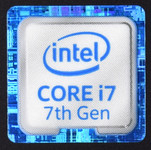
Intel's Core i7-7500U has replaced Intel's Core i7-6500U Skylake model, and has approximately 10% more performance, thanks to a somewhat higher clock rate. Intel's Core i7-7500U is the maximum that can be installed into Lenovo ThinkPad 13 (2017). In terms of performance, the processor's potential is retrieved well as the Cinebench benchmarks also confirm. All three models with Intel's Core i7-7500U calculate at roughly the same speed and there is no clear winner. The performance difference compared to the often installed Intel Core i5-7200U is approximately 10%. The processor's performance is not throttled in battery mode.
The new ThinkPad 13 also does a good job during permanent load. A slight performance drop can be observed when the TDP limit (15 watts) sets in, but the Cinebench R15 multi-loop scores are constant after that.
More benchmarks concerning Intel's Core i7-7500U can be found here.
| Cinebench R15 | |
| CPU Single 64Bit | |
| Asus Zenbook UX310UA-FC347T iGP | |
| Lenovo ThinkPad 13-20J2S00G00 | |
| HP ProBook 430 G4-Y8B47EA | |
| Dell XPS 13 9360 FHD i5 | |
| Lenovo ThinkPad 13-20GKS01100 | |
| CPU Multi 64Bit | |
| Lenovo ThinkPad 13-20J2S00G00 | |
| Asus Zenbook UX310UA-FC347T iGP | |
| HP ProBook 430 G4-Y8B47EA | |
| Dell XPS 13 9360 FHD i5 | |
| Lenovo ThinkPad 13-20GKS01100 | |
| Cinebench R11.5 | |
| CPU Single 64Bit | |
| Lenovo ThinkPad 13-20J2S00G00 | |
| Asus Zenbook UX310UA-FC347T iGP | |
| Dell XPS 13 9360 FHD i5 | |
| CPU Multi 64Bit | |
| Lenovo ThinkPad 13-20J2S00G00 | |
| Asus Zenbook UX310UA-FC347T iGP | |
| Dell XPS 13 9360 FHD i5 | |
| Cinebench R10 | |
| Rendering Single CPUs 64Bit | |
| Asus Zenbook UX310UA-FC347T iGP | |
| Lenovo ThinkPad 13-20J2S00G00 | |
| Rendering Multiple CPUs 64Bit | |
| Asus Zenbook UX310UA-FC347T iGP | |
| Lenovo ThinkPad 13-20J2S00G00 | |
| JetStream 1.1 - Total Score | |
| Lenovo ThinkPad 13-20J2S00G00 | |
| Asus Zenbook UX310UA-FC347T iGP | |
| HP ProBook 430 G4-Y8B47EA | |
| Lenovo ThinkPad 13-20GKS01100 | |
| Octane V2 - Total Score | |
| Lenovo ThinkPad 13-20J2S00G00 | |
| HP ProBook 430 G4-Y8B47EA | |
| Asus Zenbook UX310UA-FC347T iGP | |
| Dell XPS 13 9360 FHD i5 | |
| Lenovo ThinkPad 13-20GKS01100 | |
| Mozilla Kraken 1.1 - Total | |
| Lenovo ThinkPad 13-20GKS01100 | |
| Asus Zenbook UX310UA-FC347T iGP | |
| Lenovo ThinkPad 13-20J2S00G00 | |
| HP ProBook 430 G4-Y8B47EA | |
* ... Moindre est la valeur, meilleures sont les performances
System Performance
The subjective system performance was convincing during the test period. As expected, the three review samples with Intel's Core i7-7500U lead the field. However, unlike the previous Cinebench benchmarks, the percentage differences are slightly higher among them. Asus' ZenBook UX310UA prevails and relegates Lenovo's ThinkPad 13 (2017) to second place. For CPU-related reasons, Dell's XPS 13 9360 (Intel Core i5-7200U) and Lenovo's ThinkPad 13 (Intel Core i5-6200U) line in consecutively.
| PCMark 8 | |
| Home Score Accelerated v2 | |
| Asus Zenbook UX310UA-FC347T iGP | |
| Lenovo ThinkPad 13-20J2S00G00 | |
| HP ProBook 430 G4-Y8B47EA | |
| Dell XPS 13 9360 FHD i5 | |
| Lenovo ThinkPad 13-20GKS01100 | |
| Work Score Accelerated v2 | |
| Asus Zenbook UX310UA-FC347T iGP | |
| Lenovo ThinkPad 13-20J2S00G00 | |
| HP ProBook 430 G4-Y8B47EA | |
| Dell XPS 13 9360 FHD i5 | |
| Lenovo ThinkPad 13-20GKS01100 | |
| Creative Score Accelerated v2 | |
| Asus Zenbook UX310UA-FC347T iGP | |
| HP ProBook 430 G4-Y8B47EA | |
| Lenovo ThinkPad 13-20J2S00G00 | |
| Dell XPS 13 9360 FHD i5 | |
| Lenovo ThinkPad 13-20GKS01100 | |
| PCMark 7 - Score | |
| Asus Zenbook UX310UA-FC347T iGP | |
| HP ProBook 430 G4-Y8B47EA | |
| Lenovo ThinkPad 13-20J2S00G00 | |
| PCMark Vantage Result | 16210 points | |
| PCMark 7 Score | 5189 points | |
| PCMark 8 Home Score Accelerated v2 | 3705 points | |
| PCMark 8 Creative Score Accelerated v2 | 4583 points | |
| PCMark 8 Work Score Accelerated v2 | 4838 points | |
Aide | ||
Storage Device
The predecessor of Lenovo's ThinkPad 13 (2017) had an M.2 interface that was only connected via SATA III. It is very good that Lenovo has modernized this in the new model. Now SSDs can process data at a PCIe 3.0 x4 (32 Gbit/s) speed via the M.2 interface. The 512 GB SSD by Toshiba achieves 1825 MB/s in sequential read and still 942 MB/s in sequential write. We ascertained these outcomes with AS SSD. We particularly like the 4K read and write rates of this model. Many small files can even be loaded and processed quickly, which is very important in practice.
| Lenovo ThinkPad 13-20J2S00G00 Toshiba NVMe THNSF5512GPUK | Lenovo ThinkPad 13-20GKS01100 Samsung SSD PM871 MZNLN256HCHP | HP ProBook 430 G4-Y8B47EA SanDisk SD8SNAT256G1002 | Asus Zenbook UX310UA-FC347T iGP Micron SSD 1100 (MTFDDAV256TBN) | Dell XPS 13 9360 FHD i5 Toshiba NVMe THNSN5256GPUK | |
|---|---|---|---|---|---|
| CrystalDiskMark 3.0 | -41% | -49% | -39% | -3% | |
| Read Seq (MB/s) | 1143 | 461.7 -60% | 505 -56% | 489.4 -57% | 1233 8% |
| Write Seq (MB/s) | 653 | 297.8 -54% | 328.9 -50% | 431.6 -34% | 733 12% |
| Read 512 (MB/s) | 629 | 351.6 -44% | 313.6 -50% | 356.7 -43% | 1036 65% |
| Write 512 (MB/s) | 518 | 298.4 -42% | 301 -42% | 389.1 -25% | 439.9 -15% |
| Read 4k (MB/s) | 31.96 | 31.85 0% | 21.69 -32% | 26.68 -17% | 29.31 -8% |
| Write 4k (MB/s) | 138.5 | 68.5 -51% | 80.4 -42% | 88.7 -36% | 116.9 -16% |
| Read 4k QD32 (MB/s) | 578 | 360.9 -38% | 132.2 -77% | 246.3 -57% | 479.2 -17% |
| Write 4k QD32 (MB/s) | 443.1 | 276.2 -38% | 258.8 -42% | 251.5 -43% | 218.3 -51% |
Graphics Card
Intel's HD Graphics 620 is responsible for video output, and thus replaces Intel's HD Graphics 520 of the predecessor. The CPU-integrated graphics card clocks at a maximum of 1050 MHz. The graphics unit's power is sufficient for everyday tasks. A second RAM module could retrieve a bit more performance (dual-channel). The synthetic benchmark scores are on the expected level.
More benchmarks concerning Intel's HD Graphics 620 can be found here.
| 3DMark 11 - 1280x720 Performance GPU | |
| Asus Zenbook UX310UA-FC347T iGP | |
| Dell XPS 13 9360 FHD i5 | |
| Lenovo ThinkPad 13-20J2S00G00 | |
| HP ProBook 430 G4-Y8B47EA | |
| Lenovo ThinkPad 13-20GKS01100 | |
| 3DMark | |
| 1280x720 Cloud Gate Standard Graphics | |
| Asus Zenbook UX310UA-FC347T iGP | |
| Dell XPS 13 9360 FHD i5 | |
| HP ProBook 430 G4-Y8B47EA | |
| Lenovo ThinkPad 13-20GKS01100 | |
| 1920x1080 Fire Strike Graphics | |
| Asus Zenbook UX310UA-FC347T iGP | |
| Dell XPS 13 9360 FHD i5 | |
| HP ProBook 430 G4-Y8B47EA | |
| Lenovo ThinkPad 13-20GKS01100 | |
| 3DMark 03 Standard | 17494 points | |
| 3DMark 05 Standard | 10111 points | |
| 3DMark 06 Standard Score | 7722 points | |
| 3DMark Vantage P Result | 5500 points | |
| 3DMark 11 Performance | 1619 points | |
Aide | ||
Gaming Performance
Lenovo's ThinkPad 13 (2017) is a pure office device, and consequently the performance of the integrated Intel's HD Graphics 620 graphics unit is only enough to render older games, such as "BioShock", in minimum settings smoothly. Although the performance of Intel's HD Graphics 620 can be boosted slightly via a second RAM module, the user should not expect miracles. Depending on the game and settings, this could lead to a 20 to 30% higher performance.
| Bas | Moyen | Élevé | Ultra | |
|---|---|---|---|---|
| BioShock Infinite (2013) | 44 | 25 | 21 | 6 |
| Battlefield 4 (2013) | 33 | 26 | 17 | 6 |
| The Witcher 3 (2015) | 13 | 10 | 5 | |
| Rise of the Tomb Raider (2016) | 15 | 9 | 6 |
Emissions
System Noise
Lenovo's new ThinkPad 13 also runs quietly and sometimes even silently. Average load causes the noise level to increase only marginally to 31.9 dB(A). It does not get louder during full load: With just 31.9 dB(A), Lenovo's ThinkPad 13 (2017) is the quietest device in this test.
Fortunately, we did not discover the issue of the predecessor, and thus unpleasant side noises are not produced. The predecessor's small fan increased its speed to maximum roughly every two seconds, which was nerve-wracking. The fan becomes active only when it is really needed. We did not discern other interfering noises, such as coil whining.
Degré de la nuisance sonore
| Au repos |
| 29.1 / 29.1 / 29.1 dB(A) |
| Fortement sollicité |
| 31.9 / 31.9 dB(A) |
 | ||
30 dB silencieux 40 dB(A) audible 50 dB(A) bruyant |
||
min: | ||
| Lenovo ThinkPad 13-20J2S00G00 i7-7500U, HD Graphics 620 | Lenovo ThinkPad 13-20GKS01100 6200U, HD Graphics 520 | HP ProBook 430 G4-Y8B47EA i7-7500U, HD Graphics 620 | Asus Zenbook UX310UA-FC347T iGP i7-7500U, HD Graphics 620 | Dell XPS 13 9360 FHD i5 i5-7200U, HD Graphics 620 | |
|---|---|---|---|---|---|
| Noise | -1% | -3% | -7% | 0% | |
| arrêt / environnement * (dB) | 29.1 | 29.1 -0% | 29.1 -0% | 30.7 -5% | |
| Idle Minimum * (dB) | 29.1 | 29.1 -0% | 29.1 -0% | 30.9 -6% | 28.9 1% |
| Idle Average * (dB) | 29.1 | 29.1 -0% | 29.1 -0% | 30.9 -6% | 28.9 1% |
| Idle Maximum * (dB) | 29.1 | 29.1 -0% | 29.1 -0% | 30.9 -6% | 28.9 1% |
| Load Average * (dB) | 31.9 | 31.5 1% | 33.4 -5% | 35.6 -12% | 30.9 3% |
| Load Maximum * (dB) | 31.9 | 33.5 -5% | 36 -13% | 34.1 -7% | 33.5 -5% |
* ... Moindre est la valeur, meilleures sont les performances
Temperature
The casing's temperature without load is rather inconspicuous. Hot spots are not visible and everything is within an acceptable range with a maximum of 25.6 °C (~78 °F). However, the tide turns during maximum load, and it is not only the internal temperatures that climb. We measured a maximum of 54.7 °C (~130 °F) on the casing's upper side in the rear area. This is quite high and can get unpleasant when the device is used on the lap for prolonged periods.
We measure a maximum CPU temperature of 79 °C (~174 °F) inside when the laptop is loaded with Prime95. Thus, the processor clocks within the specifications and thermal throttling does not occur. The clock speed of 3.0 GHz can be maintained stably for over an hour.
The GPU and CPU have to share the available performance in the stress test via Prime95 and FurMark. Thus, the CPU clocks at an average of 1.7 GHz, and Intel's HD Graphics 620 clocks at 1.0 GHz. We measure 73 °C (~163 °F) on the graphics unit and now only 72 °C (~162 °F) on the processor. Overall, Lenovo has the components' temperatures well under control, even though at 54.7 °C (~130 °F) the casing's underside is simply too warm.
(±) La température maximale du côté supérieur est de 44.7 °C / 112 F, par rapport à la moyenne de 34.3 °C / 94 F, allant de 21.2 à 62.5 °C pour la classe Office.
(-) Le fond chauffe jusqu'à un maximum de 54.7 °C / 130 F, contre une moyenne de 36.8 °C / 98 F
(+) En utilisation inactive, la température moyenne du côté supérieur est de 23.5 °C / 74 F, par rapport à la moyenne du dispositif de 29.5 °C / 85 F.
(±) Les repose-poignets et le pavé tactile peuvent devenir très chauds au toucher, avec un maximum de 39.8 °C / 103.6# F.
(-) La température moyenne de la zone de l'appui-paume de dispositifs similaires était de 27.6 °C / 81.7 F (-12.2 °C / #-21.9 F).
| Lenovo ThinkPad 13-20J2S00G00 i7-7500U, HD Graphics 620 | Lenovo ThinkPad 13-20GKS01100 6200U, HD Graphics 520 | HP ProBook 430 G4-Y8B47EA i7-7500U, HD Graphics 620 | Asus Zenbook UX310UA-FC347T iGP i7-7500U, HD Graphics 620 | Dell XPS 13 9360 FHD i5 i5-7200U, HD Graphics 620 | |
|---|---|---|---|---|---|
| Heat | -9% | -0% | 16% | 0% | |
| Maximum Upper Side * (°C) | 44.7 | 43.7 2% | 38.7 13% | 33.7 25% | 43.4 3% |
| Maximum Bottom * (°C) | 54.7 | 44.2 19% | 39.4 28% | 34.1 38% | 49.2 10% |
| Idle Upper Side * (°C) | 24.2 | 31.4 -30% | 29.5 -22% | 25.2 -4% | 26.4 -9% |
| Idle Bottom * (°C) | 25.6 | 32.1 -25% | 30.6 -20% | 24.1 6% | 26.4 -3% |
* ... Moindre est la valeur, meilleures sont les performances
Speakers
In terms of the sound system nothing has changed compared with the predecessor. Both speaker openings on the underside are clearly visible. The sound could muffle audibly on soft surfaces. A hint of stereo can be perceived thanks to their positioning. Overall, the sound of both speakers is quite decent and much better than some older ThinkPads. The prevailing high and mid tones underline the lack of a subwoofer. The maximum volume of 75.9 dB(A) is too weak for large rooms. However, the speakers are quite sufficient for video calls. The Dolby Audio software provides some tweaks for customizing the sound. External players can be connected to Lenovo's ThinkPad 13 (2017) via the jack, Bluetooth or HDMI.
Lenovo ThinkPad 13-20J2S00G00 analyse audio
(±) | le niveau sonore du haut-parleur est moyen mais bon (74.1# dB)
Basses 100 - 315 Hz
(-) | presque aucune basse - en moyenne 16.3% plus bas que la médiane
(±) | la linéarité des basses est moyenne (11.1% delta à la fréquence précédente)
Médiums 400 - 2000 Hz
(±) | médiane supérieure - en moyenne 6.2% supérieure à la médiane
(±) | la linéarité des médiums est moyenne (8.8% delta à la fréquence précédente)
Aiguës 2 - 16 kHz
(+) | des sommets équilibrés - à seulement 2% de la médiane
(+) | les aigus sont linéaires (6.9% delta à la fréquence précédente)
Globalement 100 - 16 000 Hz
(±) | la linéarité du son global est moyenne (21.3% de différence avec la médiane)
Par rapport à la même classe
» 51% de tous les appareils testés de cette catégorie étaient meilleurs, 9% similaires, 40% pires
» Le meilleur avait un delta de 7%, la moyenne était de 21%, le pire était de 53%.
Par rapport à tous les appareils testés
» 59% de tous les appareils testés étaient meilleurs, 7% similaires, 34% pires
» Le meilleur avait un delta de 4%, la moyenne était de 24%, le pire était de 134%.
HP ProBook 430 G4-Y8B47EA analyse audio
(+) | les haut-parleurs peuvent jouer relativement fort (84.6# dB)
Basses 100 - 315 Hz
(-) | presque aucune basse - en moyenne 19.7% plus bas que la médiane
(±) | la linéarité des basses est moyenne (13.1% delta à la fréquence précédente)
Médiums 400 - 2000 Hz
(+) | médiane équilibrée - seulement 3.8% de la médiane
(+) | les médiums sont linéaires (6.8% delta à la fréquence précédente)
Aiguës 2 - 16 kHz
(±) | sommets plus élevés - en moyenne 5.7% plus élevés que la médiane
(+) | les aigus sont linéaires (5.4% delta à la fréquence précédente)
Globalement 100 - 16 000 Hz
(±) | la linéarité du son global est moyenne (18.9% de différence avec la médiane)
Par rapport à la même classe
» 34% de tous les appareils testés de cette catégorie étaient meilleurs, 7% similaires, 59% pires
» Le meilleur avait un delta de 7%, la moyenne était de 21%, le pire était de 53%.
Par rapport à tous les appareils testés
» 43% de tous les appareils testés étaient meilleurs, 8% similaires, 49% pires
» Le meilleur avait un delta de 4%, la moyenne était de 24%, le pire était de 134%.
Frequency diagram in comparison (checkboxes above can be turned on/off!)
Energy Management
Power Consumption
Our review sample proves to be power efficient in the consumption measurements. A direct comparison clearly shows that both HP's ProBook 430 and Asus's ZenBook UX310UA consume considerably more power. Only the two devices with Intel's Core i5 are rather more efficient than Lenovo's ThinkPad 13 (2017). The idle power consumption of our review sample is 3.16 to 6.5 watts. This climbs to 35.8 watts for a moment in the stress test. The load consumption settles at an average of 30.6 watts.
We still measure 0.51 when the device is shut down and 0.55 watts in standby mode. Lenovo should improve this in future devices as the rates are slightly high.
The included 45-watt power supply has enough capacity. By the way, Lenovo's ThinkPad 13 (2017) can also be supplied with power via the USB C port.
| Éteint/en veille | |
| Au repos | |
| Fortement sollicité |
|
Légende:
min: | |
| Lenovo ThinkPad 13-20J2S00G00 i7-7500U, HD Graphics 620 | Lenovo ThinkPad 13-20GKS01100 6200U, HD Graphics 520 | HP ProBook 430 G4-Y8B47EA i7-7500U, HD Graphics 620 | Asus Zenbook UX310UA-FC347T iGP i7-7500U, HD Graphics 620 | Dell XPS 13 9360 FHD i5 i5-7200U, HD Graphics 620 | |
|---|---|---|---|---|---|
| Power Consumption | 8% | -14% | -12% | 13% | |
| Idle Minimum * (Watt) | 3.16 | 3.1 2% | 4.2 -33% | 3.5 -11% | 4.1 -30% |
| Idle Average * (Watt) | 5.9 | 5.5 7% | 6.5 -10% | 6.6 -12% | 4.2 29% |
| Idle Maximum * (Watt) | 6.5 | 6 8% | 7.2 -11% | 7.5 -15% | 5.1 22% |
| Load Average * (Watt) | 30.6 | 25.8 16% | 28.7 6% | 34.7 -13% | 22.1 28% |
| Load Maximum * (Watt) | 35.8 | 33.6 6% | 43.5 -22% | 39.6 -11% | 29.4 18% |
* ... Moindre est la valeur, meilleures sont les performances
Battery Runtime
The non-removable, 3-cell battery (lithium polymer) in Lenovo's ThinkPad 13 (2017) has a capacity of 42 Wh. Despite its low capacity, the battery life is quite good. One battery charge is enough for 15:04 hours without load. Almost 8 hours are possible before the device has to be plugged into an outlet in the Wi-Fi test. However, the battery is depleted after just 1:25 hours of full load. Lenovo's ThinkPad 13 (2017) needs 1:21 hours for recharging the battery.
Lenovo's ThinkPad 13 (2017) is adequately equipped for a workday when used moderately. However, the power supply should be kept at hand for emergencies. The 3D performance is not reduced in battery mode. We ran 3DMark 11 and did not determine any big differences.
| Lenovo ThinkPad 13-20J2S00G00 i7-7500U, HD Graphics 620, 42 Wh | Lenovo ThinkPad 13-20GKS01100 6200U, HD Graphics 520, 42 Wh | HP ProBook 430 G4-Y8B47EA i7-7500U, HD Graphics 620, 48 Wh | Asus Zenbook UX310UA-FC347T iGP i7-7500U, HD Graphics 620, 48 Wh | Dell XPS 13 9360 FHD i5 i5-7200U, HD Graphics 620, 60 Wh | |
|---|---|---|---|---|---|
| Autonomie de la batterie | 22% | 41% | 25% | 57% | |
| Reader / Idle (h) | 15.1 | 15.7 4% | 15.9 5% | 16.1 7% | 21.6 43% |
| H.264 (h) | 5.2 | 7.8 50% | 8.7 67% | 6.9 33% | |
| WiFi v1.3 (h) | 7.9 | 6.2 -22% | 7.2 -9% | 9.6 22% | 11.3 43% |
| Load (h) | 1.4 | 2.2 57% | 2.8 100% | 1.9 36% | 2.6 86% |
Points positifs
Points négatifs
Verdict
Le ThinkPad 13 2017 constitue un bon PC portable d'entrée de gamme pour le secteur professionnel. Les performances qu'il offre justifient son prix de 1230 € (~1329 $US). Les acheteurs obtiennent un CPU Intel Core i7-7500U performant qui offre tout son potentiel, même sous sollicitation intense (pas de bridage thermique). Le SSD PCIe NVMe de 512 Go assure une très bonne fluidité du système. La mémoire RAM DDR4 de 8 Go est suffisante pour la majorité des usages visés, et elle peut être augmentée si nécessaire par le biais du second emplacement disponible.
Le ThinkPad 13 2017 attire tout d'abord l'attention sur le secteur professionnel grâce à son bon rapport prix-performances. Les utilisateurs n'utilisant pas de SmartCard et que la garantie de seulement 12 mois ne gène pas, devraient s’intéresser à la gamme ThinkPad 13.
Comme mentionné, l'absence de lecteur de SmartCard non disponible également en option, pourrait pousser de potentiels acheteurs vers d'autres machines qui proposent cette fonctionnalité. De façon globale, nous avons vraiment apprécié la version 2017 du ThinkPad 13. Ses points forts se trouvent du côté des bons périphériques d'entrée et des bonnes performances globales. L'écran par contre est plutôt mitigé; sa bonne luminosité est impactée par une couverture limitée des espaces de couleurs. Cependant, ces points de critique ne devraient pas jouer un grand rôle dans la décision d'achat, si le ThinkPad est destiné à remplacer un PC de bureau fixe grâce à une station d'accueil disponible en option.
Pour plus de détails, la version complète de ce test (en anglais) est disponible ici.
Lenovo ThinkPad 13-20J2S00G00
- 03/20/2017 v6 (old)
Sebastian Bade




